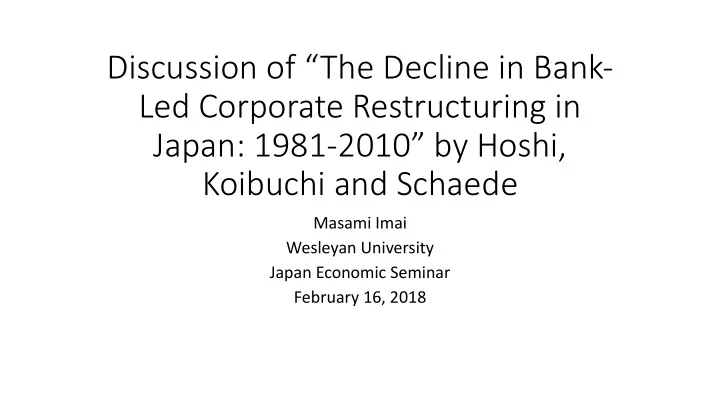

Discussion of “The Decline in Bank- Led Corporate Restructuring in Japan: 1981-2010” by Hoshi, Koibuchi and Schaede Masami Imai Wesleyan University Japan Economic Seminar February 16, 2018
What This Paper Does • Use the firm-level accounting data to identify distressed firms from 1981-2010 in Japan • In addition, perform newspaper search to identify firms that underwent corporate restructuring • Putting together these two pieces of information to: • Describe the evolution of corporate restructuring over three decades • Measure the economic impact of corporate restructuring
Results • The incident of corporate restructuring (relative to that of financial distress) declined over time • Distressed firms were less likely to undergo restructuring during the 1990s and thereafter, compared to the 1980s • Corporate restructuring seems to have been effective as it involved the restructuring of loans along with real adjustment in employment and firm assets • The paper also present some evidence that restructuring, once completed, had some positive effects on firm performance • But evidence here is less clear….
Data on Restructuring • Very unique • I am not aware of any data like these for Japan (or any other countries) • It is an extremely labor-intensive task • Newspaper search for Saiken • In addition, the authors read through each piece to determine whether a firm’s main banks was involved, etc. • Went through through each page of Kaisha Shikoho/Kigyo Keiretsu Soran to ensure that the Saiken data are complete • The completed data: 30 years of data from 1981-2010 on 3772 unique firms • 950 episodes of Saiken for 517 firms • 929 identified in newspaper search • It goes without saying that they put together a valuable data set that shines an important light on the evolution of corporate governance in Japan
Four Waves of Financial Ditress/Saiken Incidents • The first wave when the yen appreciated sharply in the mid 1980s • The second wave when the bubble collapsed in the early 1990s • The third wave during the financial crisis (the late 1990s). • It was a large shock as indicated by a sharp increase in the number of distressed firms • But, we do not see a lot of action in Saiken • The fourth wave during the 2008 global economic crisis • Another large negative shock, but while distressed firms increased, Saiken firms declined! • Macroeconomic shocks alone cannot explain these diverging patterns!
We have seen a similar graph in Caballero, Hoshi, and Kashyap (AER 2008)….. • Banks subsidized firms during the period of negative macroeconomic shocks • The endaka shock in the mid 1980s • The collapse of asset prices in the early 1990s) • Banks’ subsidies seem more permanent in the second wave, despite fluctuating macroeconomic conditions • A part of this is due to the persistent underperformance of the Japanese economy, • But, there is more to the story as the incident of corporate restructuring declined, relative to financial distress, at the same time
Questions/Comments • Main banks have weaker incentives to lead restructuring efforts as their financial stakes in their client firms are not as significant as before • The paper shows some evidence of this as the probability of Saiken is related positively to main bank dependence • How about the bank’s incentive to hide non-performing loans? • Any differences between firms whose main banks were nearly insolvent and those whose main banks were relatively healthy? • Incorporate the data on bank health to uncover diverging patterns between two groups • Maybe, the data series on financial distress and Saiken co-moved more tightly for firms whose main banks are relatively healthy
Real Economic Impact of Saiken • Tough to estimate the real economic impact of corporate restructuring, econometrically • Selection issues • Why some firms restructured while others did not? • Positive selection or negative selection? • Hard to deal with… • In addition, control group here is a group of similar firms that did not undergo Saiken • Once fully recovered, Saiken firms probably did not receive subsidized loans while zombie firms might have continued to receive them, which, in turn, allowed them to hoard labor and capital • Measuring firm performance with TFP growth might make the effects of restructuring clearer • Saiken firms produce more output with less input while zombie firms produce just as much (or more) but they use a lot more inputs
Make the Data on Saiken Longer • It will be interesting to examine what it looked like in the 60s and 70s when financial regulation was tighter • Of course, it will be also interesting to see whether the reform of bankruptcy law had any positive impacts on the incident of Saiken in more recent time period
Recommend
More recommend